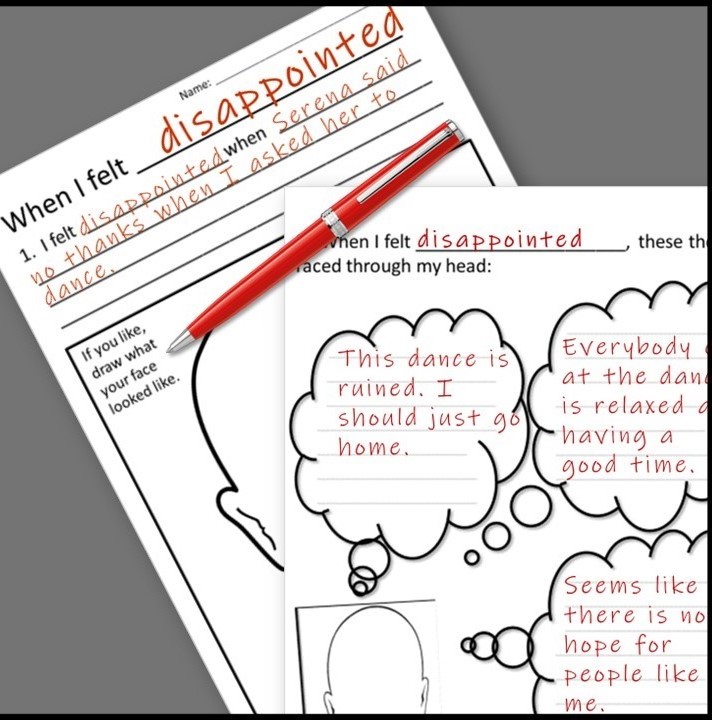Some reasons to use art
A. Art can add levity and variety to social-emotional learning.

By the time young people with ASD find themselves in our offices and classrooms, they may have experienced a lot of stress, confusion and disappointment with their social and emotional learning. Incorporating some art into our therapy and teaching activities can be one good way to make this difficult work fresh and interesting for many of them.
B. Incorporating art into therapy activities can help to reduce emphasis on spoken exchange in our counseling and teaching.
For many young people with autism, uninterrupted, reciprocal spoken exchange – especially face-to-face – can cause fatigue and resistance.
Having the child look downwards towards a therapeutic art project, rather than constantly upward to meet the adult’s gaze, can actually have the effect of increasing focus and stamina.

C. Artistic expression can enhance self-revelation and self-reflection.
We often ask children to do hard and painful work in our therapy sessions. Our queries about their problems must feel like relentless interrogation sometimes. Furthermore, the thoughts and feelings we ask children to reveal might be challenging to articulate or uncomfortable for them to put into spoken words. Drawing and coloring offer children other ways to communicate with us.

D. Drawing and coloring are activities which in themselves can be calming and centering for many people.

Helping children to feel good and relaxed during our sessions with them can help them get ready to talk about problems. I have often seen young people in individual or group therapy calm themselves while coloring and drawing. Frequently, while holding crayons, markers and colored pencils, they seem more amenable to talking about things that are troubling them.
E. Artistic expression can offer a medium for collaboration and connection.
Employing creative expression can help a child to work more effectively with an adult.
Introducing even a little bit of drawing, coloring or cutting something out can help a child to feel engaged with therapy activities introduced by the adult.
Facilitating art activities can connect socially isolated children with other people.
In my group therapy sessions and classroom interventions, I have often observed children forming social and emotional bonds while looking at the drawings and artistic creations of other young people. Helping children to show their art to others can facilitate social connections for autistic youth, many of whom are accustomed to doing their art entirely in private.
Facilitating collaborative art activities can strengthen perspective taking and working with others.
Coaching autistic children while they are working on creative group projects can help them acquire valuable experience in understanding other points of view and creative preferences.
Principles & professional practices when using art in social-emotional teaching
A. Maintain focus on your therapeutic agenda.

Therapy activities involving art should always have therapeutic benefit – that is, they should all work towards promotion of improved social communication, interaction and emotional regulation. Our art-based activities should focus attention on the therapy, and if drawing and coloring is merely diverting, it’s best to switch methods. Although it may be useful on occasion to use an art activity as a reward, but a rule a therapist or teacher should avoid doing art just for fun or to “kill time.” Above all, we should resist the temptation to assign art activities just because kids find it enjoyable or because we happen to find their art interesting or endearing.
B. Facilitate artistic expression. Don’t force it.
Usually it’s best to provide the options of drawing, or writing, or both. Here is an example below. The person using the CBT Worksheets shown here can draw in the face outline or leave it blank.
Since an art-based intervention might not work out, we should always be prepared with back-up activities that do not emphasize artistic expression.
C. Account for ability levels and preferences.
Allow for different kinds of intelligence, dexterity, drawing ability, writing ability.

Take into account the age level of participants, but don’t dismiss activities that might be perceived as too juvenile by neurotypical youth. Autistic teens and even young adults might accept and greatly benefit from activities that neurotypical teens might consider too “childish.”
D. Respect privacy and authorship.
Avoid sharing, distributing or posting a child’s art unless you have the child’s permission, a parent’s permission and a valid therapeutic reason for sharing the art.
The next in this series is: Part 2: Assigning individual drawing tasks for social & emotional learning.
Joel Shaul, LCSW
Part 2: Assigning individual drawing tasks for social & emotional learning.
Part 3: Assigning collaborative drawing tasks for social learning.
Part 4: Coloring & decorating to add interest & levity to social & emotional learning.
Part 5: Creative use of others’ images and AI for social & emotional learning.
Part 6: Encouraging & validating the child’s own artistic expression in therapy & teaching.



